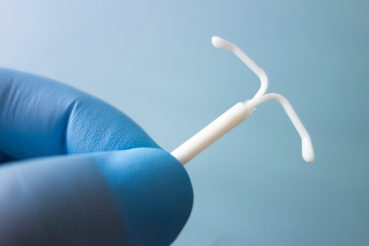For women who suffer from migraines, finding relief can be challenging. One reason is that these are more than just headaches. In fact, a headache is actually a symptom of migraines. Other symptoms can include nausea; vomiting; and sensitivity to light, sound and smell.
Another potential hurdle to relieving migraines: the myriad treatment options — including Botox, implantable nerve stimulators, surgical nerve decompression, medications, supplements, herbs and acupuncture — and their potential side effects. But one form of migraine treatment that can be particularly problematic for some women is birth control.
Hormone changes can cause migraines, and hormonal contraceptives can help regulate these changes and reduce migraines. The catch? Using certain types of oral contraceptives to treat migraines can also put certain women at greater risk for stroke.
Malathi Rao, DO, a neurologist at Rush South Loop, explains why birth control can potentially be risky for migraines and how you can decide which treatment option will work best for you.
The problem with hormonal imbalances
Migraines affect 12% of the U.S. population — including children, according to the Migraine Research Foundation. They can run in families, and more women than men (18% vs. 6%) experience them largely due to hormonal changes.
Generally, migraines are launched by triggers, such as environmental factors, dietary components and hormonal changes. Shifts in hormones occur throughout a woman’s menstrual cycle. Usually around the time of ovulation, when eggs are released from the ovaries, women have a big surge in estrogen. Then right before the menstrual cycle begins, estrogen levels drop.
"It’s usually that drop in estrogen that will trigger a menstrual migraine," Rao explains.
In some cases, hormonal contraceptives can help manage migraines — and even prevent them — since they help regulate estrogen levels. This type of birth control comes in various forms:
- Combined oral contraceptives
- Injectable progestogens
- Intrauterine devices (IUDs)
- Progesterone-only pills
Combined oral contraceptives have both estrogen and progesterone (a hormone that helps support and maintain pregnancy by thickening the wall of the uterus). But controlling estrogen levels can be tricky because of how birth control is formulated and which type of migraine you have.
"In the 1960s and '70s when birth control was just coming out, they contained higher doses of estrogen," Rao says.
In 1975, the risk of stroke with combined oral contraceptives was first reported in JAMA. It was not until 1996 that the World Health Organization (WHO) reported that a higher risk of stroke was associated with combined oral contraceptives containing higher doses of estrogen.
"But now, we have lower-dose estrogen formulation along with non-estrogen options," Rao adds.
The other factor complicating matters is that migraines differ, so the kind you have determines how you respond to birth control.
What is a migraine with aura?
Not all migraines are the same, and they largely fall into two main categories:
- Migraine without aura (common migraine)
- Migraine with aura (complicated migraine)
Menstrual migraines are a subtype that can fall into either category.
According to the American Migraine Foundation, about one-quarter of those who have migraines also experience aura. Aura is a series of visual and sensory changes that may include any and all of the following:
- Inability to speak clearly
- Seeing black dots, zig zags or other unusual visual patterns
- Tingling and numbness on one side of the body
These changes may happen right before or during a migraine attack and may last anywhere from 10 minutes to a half-hour. No matter how long it lasts, aura is an unmistakable warning notice that a migraine is imminent.
The American Migraine Foundation reports that women younger than age 45 who have migraine with aura are already at higher risk for ischemic stroke. These women may be more likely to form blood clots due to inflammation, abnormalities in coagulation and dysfunction of the blood vessels.
For women who suffer from migraines with aura, taking combined oral contraceptives heightens their stroke risk even more. It’s specifically the hormone estrogen in the oral contraceptive that can cause a stroke. "Estrogen has properties that can cause your blood to clot easier," Rao says.
Blood clots have the potential to form in an artery that supplies blood to the brain. When the clot prevents or blocks blood flow to the brain, it can cause a stroke.
Know the signs of a stroke. Time lost equals brain cells lost so learn to act FAST.
Once you’ve identified what a true aura is, you can determine whether it's significant enough or if it's a true aura with a migraine. From there, with help from your physician, you can determine if birth control is a viable treatment option.
"There are some people who are candidates for it, and there are some who are not. And again, the dose of the estrogen really matters," Rao says. "If you are deemed to be a good candidate for considering the combined oral contraceptive, you have to weigh the risks vs. the benefits."
There's been a lot of debate in the medical community about whether the ultra-low-dose estrogen compound is safe, but no consensus yet.
"I think most doctors would err on the side of saying, 'Let's hold off prescribing the oral contraceptive unless you meet very specific criteria,'" Rao says. "There's good reason to be hesitant. What I usually tell my patients is that if you have a migraine with an aura, and the aura frequency is less than once a month, there is a risk of stroke two times greater than in women without migraine."
If the aura frequency is more than once a week, the risk is greater than four times.
Determining what hormonal contraceptive is right for you
Having migraine with aura is not the only deciding factor on whether and what type of hormonal contraceptive to use.
Women who are not good candidates for combined oral contraceptives include the following:
- Those over age 35
- Smokers
- Those who have multiple risk factors for stroke, such as high blood pressure, high cholesterol, smoking and obesity
"I think for those women, it's an absolute no-no, and they should consider other non-estrogen contraception," Rao says. "But if you're young and healthy, you have lower vascular risk factors, and you truly do not have aura with your migraine, then I think it would be safe to consider it," she adds.
No matter which way you're leaning, however, always have the discussion with your provider first to truly determine what’s appropriate for you.




